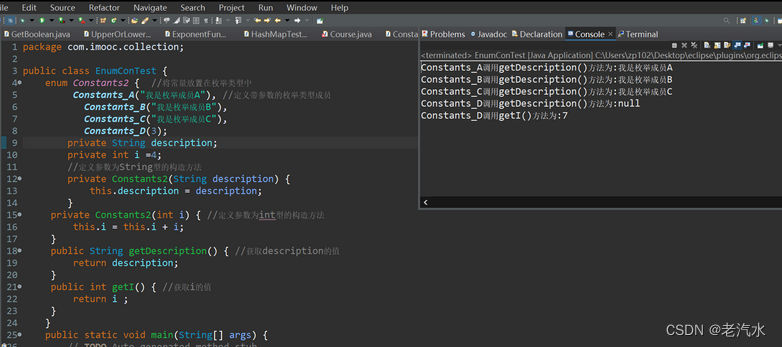目录
11.1 枚举
11.1.1 使用枚举类型设置常量
11.1.2 深入了解枚举类型
11.1.3 使用枚举类型的优势
11.2 泛型
11.2.1 回顾"向上转型" 与"向下转型"
11.2.2 定义泛型类
11.2.3 泛型的常规用法
11.2.4 泛型的高级用法
11.2.5 泛型总结
11.3 小结
例11.1
public class ConstantsTest {
enum Constants2 {//将常量放置在枚举类型中
Constants_A ,
Constants_B
}
public static void doit2(Constants2 c) { //定义一个参数对象是枚举类型的方法
switch (c) { //根据 枚举类型对象做不同操作
case Constants_A:
System.out.println("doit2() Constants_A");
break;
case Constants_B:
System.out.println("doit2() Constants_B");
break;
}
}
public static void main(String[] args) {
ConstantsTest.doit2(Constants2.Constants_A);//使用接口中定义的常量
ConstantsTest.doit2(Constants2.Constants_B); //使用枚举类型中的常量
//ConstantsTest.doit2(3);
// TODO Auto-generated method stub
}
}

例11.3
enum Constants { //将常量放在枚举类型中
Constants_A,
Constants_B,
Constants_C,
Constants_D
}
public class EnumMethodTest { //定义比较枚举类型方法,参数类型为枚举类型
public static void compare(Constants c) {
Constants array[] = Constants.values();//根据values()方法返回的数组 //将比较结果返回
for (int i =0;i < array.length;i++) {
System.out.println(c + "与" + array[i] + "的比较结果为:" + c.compareTo(array[i]));
}
} //在主方法中调用compare()方法
public static void main(String[] args) {
compare(Constants.valueOf("Constants_B"));
// TODO Auto-generated method stub
}
}

例11.4
public class EnumIndexTest {
enum Constats2 { //将常量放在枚举类型中
Constants_A,
Constants_B,
Constants_C
}
public static void main(String[] args) {
Constants2[] arrayCon = Constants2.values();
for (int i =0;i<arrayCon.length;i++) { //在循环中获取枚举类型成员的索引位置
System.out.println(arrayCon[i] + "在枚举类型中位置索引值"
+ arrayCon [i].ordinal());
}
// TODO Auto-generated method stub
}
}

例11.5
public class EnumConTest {
enum Constants2 { //将常量放置在枚举类型中
Constants_A("我是枚举成员A"), //定义带参数的枚举类型成员
Constants_B("我是枚举成员B"),
Constants_C("我是枚举成员C"),
Constants_D(3);
private String description;
private int i =4;
//定义参数为String型的构造方法
private Constants2(String description) {
this.description = description;
}
private Constants2(int i) { //定义参数为int型的构造方法
this.i = this.i + i;
}
public String getDescription() { //获取description的值
return description;
}
public int getI() { //获取i的值
return i ;
}
}
public static void main(String[] args) {
// TODO Auto-generated method stub
Constants2 array[] = Constants2.values(); //获取枚举成员数组
for(int i = 0;i<array.length;i++) {
System.out.println(array[i] + "调用getDescription()方法为:" +array[i]. getDescription());
}
Constants2 c2 = Constants2.valueOf("Constants_D"); //将字符串转换成枚举对象
System.out.println(c2 + "调用getI()方法为:" + c2.getI());
}
}
例11.7
public class Test {
private Object b; //定义Object类型成员变量
public Object getB() { //设置相应的getxxx()方法
return b;
}
public void setB(Object b) { //设置相应的setxxx()方法
this.b = b;
}
public static void main(String[] args) {
// TODO Auto-generated method stub
Test t = new Test();
t.setB(new Boolean(true)); //向上转型操作
System.out.println(t.getB());
t.setB(new Float(12.3));
Float f = (Float) (t.getB()); //向下转型操作
System.out.println(f);
}
}

1. 通过类型参数T的继承限制泛型类型
import java.util.ArrayList;
import java.util.LinkedList;
import java.util.List;
public class LimitClass <T extends List> { //限制泛型的类型
public static void main(String[] args) { //可以实例化已经实现的list接口的类
// TODO Auto-generated method stub
LimitClass<ArrayList> l1 = new LimitClass<ArrayList>();
LimitClass<LinkedList> l2 = new LimitClass<LinkedList>();
//这句是错误的,因为HashMap没有实现List()接口
//LimitListClass<HashMap> l3 = new LimitClass<HashMap>();
}
}
例11.11
import java.util.*;
public class WildClass {
public static void main(String[] args) {
// TODO Auto-generated method stub
List<String> l1 = new ArrayList<String>(); //创建一个ArrayList对象
l1.add("成员"); //在集合中添加内容
List<?> l2 = l1; //使用通配符
List<?> l3 = new LinkedList<Integer>();
System.out.println("l1:" +l1.get(0)); //获取l1集合中第一个值
System.out.println("l2:" +l2.get(0)); //获取l2集合中第一个值
l1.set(0, "成员改变"); //使用通配符的对象不能调用set()方法
//l2.add("添加"); //使用通配符的对象不能调用add方法
// l2.set(0,"成员改变"); //使用通配符的对象不能调用set方法
//13.add(1);
//13.set(0,1);
System.out.println("l1:" +l1.get(0));
}
}






















 786
786











 被折叠的 条评论
为什么被折叠?
被折叠的 条评论
为什么被折叠?








